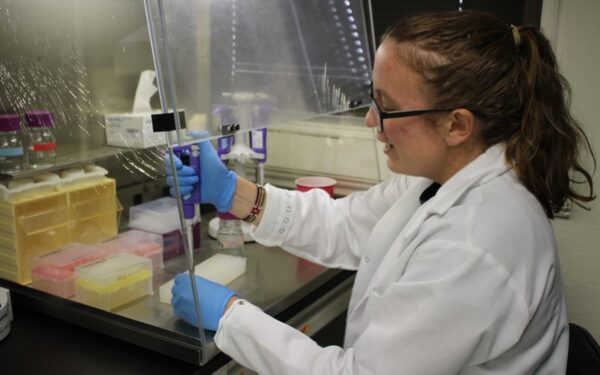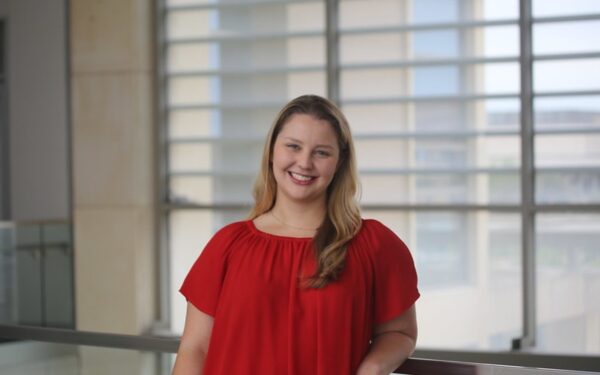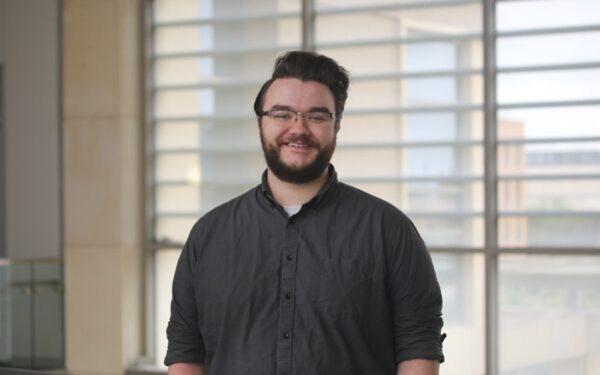2023 Lawrence S. Dillon Distinguished Graduate Student Awards
The Lawrence S. Dillon Distinguished Graduate Student Award was established in 2001 by Patricia Dillon Moore in memory of her father, a former professor in the department of biology. Dr. Dillon received his Masterʼs degree from A&M in 1950 and Doctoral degree from A&M in 1954. Dr. Dillon eventually became a professor in the department, and in 1975 he became professor emeritus. Dr. Dillon passed away in 1999, after which his daughter established this award in his memory to be presented to graduate students who excel in either research or teaching. This year’s award recipients are Jenna Hulke, Valerie Dietz, and Matt Breuer. Please read more about the recipients and their accomplishments below!
June 5, 2023 | By Jack Lee (jackjackj@tamu.edu)
Jenna Hulke

Jenna Hulke, a biology Ph.D. student from the Criscione lab, is one of the three recipients of the 2023 Lawrence S. Dillon Distinguished Graduate Student Award for excellence in research and teaching.
Earning her undergraduate degree from the University of Wisconsin-Stevens Point, Hulke walked a storied path before coming to Texas A&M.
“I graduated from the University of Wisconsin-Stevens Point, and then I took a few years off from school,” Hulke said. “From there, I worked for the American Red Cross in disaster relief for a year before working as a field ecologist at a company that does control of vector borne diseases. I worked with plague in Colorado, and then I worked with visceral leishmania, a parasite transmitted by sandflies, in India. From there, I moved to Kenya to be a Project Manager for a lab at the University of California, Santa Barbara. I lived in Kenya for two years working at watering holes, to evaluate the role watering holes play in aggregating both animals and their parasites. It was during my work in Kenya that I decided I wanted to get more involved in research.”
Under Charles Criscione, Ph.D., Hulke’s research concerns the evolution and ecology of parasitic organisms.
“I work on the evolution of parasites, and specifically, research on the evolution of parasitic life cycles,” Hulke said. “For parasites to reproduce, they require at least one host. However, many parasites require more than one host to reach a reproductive stage. My research examines why a parasite might need multiple hosts.”
Specifically, Hulke’s research examines a type of parasitic flatworm known as trematodes, commonly called flukes.
“I work with trematodes,” Hulke said. “Trematodes exhibit a great diversity in the number of hosts required for their life cycles, with the majority of trematodes requiring at least three hosts to complete a life cycle. You can imagine for a parasite, that for each host needed to complete a life cycle, the harder it becomes to reach the final host and sexually reproduce. So, if some trematodes only require two hosts, why would others need three or more hosts?”
Hulke said the current theory she is testing is that having more hosts within a life cycle promotes more outcrossing opportunities as individuals can be concentrated into hosts further up the food chain. Not only can individual parasites be concentrated into host, allowing for more outcrossing opportunities, but there is the added advantage that having more hosts allows for unrelated individuals to meet within a host.
“Trematodes have a clonal phase, where they produce hundreds or even thousands of genetically identical clonemates,” Hulke said. “These clonemates can end up in the same host, and if they mate, it is the same genetic result as a self-fertilization event, which is an extreme form of inbreeding. However, it is not only clonemate matings that can cause high amounts of inbreeding, the co-transmission of full or half siblings can also lead to inbreeding. And of course, most trematodes are hermaphroditic, an individual has both male and female gametes, so there is the chance that they self mate.”
Outside of research, Hulke has worked as a teaching assistant for several introductory biology courses.
“I always really enjoy teaching, because working with students is great,” Hulke said.
“Especially at that introductory level. When I was an undergrad myself, it was the introductory biology courses that really got me interested. It is where you find that niche of science that makes you go, ‘Oh, this is actually cool.’ … Even as a teaching assistant, the students develop an enthusiasm for a topic that you’ve never really thought about, and it makes you more interested in the topic.”
Criscione said Hulke is an asset to both science and education within the Department of Biology.
“Jenna is an outstanding graduate student because she goes the extra mile to not only accomplish research goals, but also to lend a helping hand to the Biology Department teaching mission,” Criscione said. “She is more of a colleague than a student. We are privileged to have her here at A&M and represent our department.”
Valerie Dietz

Valerie Dietz, Ph.D., a recently graduated doctoral student from the Dulin lab, is one of the three recipients of the 2023 Lawrence S. Dillon Distinguished Graduate Student Award for excellence in research and teaching.
Dietz, a first generation college student, attended Texas A&M for both undergraduate and graduate school.
“My sophomore year, I took a class with Alan Pepper, who’s still a professor in the Department of Biology, called Genes, Ecology and Evolution,” Dietz said. “It was the first class in my undergraduate career that just made sense to me. You know, as a freshman, you get thrown into all of those kinds of weed out classes, General Chemistry, General Biology, and those were so challenging for me. Then I got to his class, and it was such a good story of how all of these things are connected. He had an open research position in his lab and he announced it to the class, and I think it’s the only time in my life that I have run to a professor’s office.”
Working with Pepper, Dietz said, introduced her to academic research.
“He accepted me for that research position, and it was the first time in my life that I found out you could be a doctor without being a medical professional. I’ve always loved science growing up, and everyone told me, ‘You should be a doctor.’ In my head, that meant the very stereotypical physician,” Dietz said. “I went into college in my undergrad, pre-med bound. Then I got exposed to research and having the opportunity to participate in undergraduate research changed my whole dynamic. I felt like it was so much more fun to be on the cutting edge of science.”
Under Jennifer Dulin, Ph.D., Dietz studies spinal cord injuries.
“After a spinal cord injury, people usually think, ‘Oh, people who experience paralysis, they can’t feel anything.’ But that’s actually not true,” Dietz said. “A lot of people with a spinal cord injury experience something called neuropathic pain. It’s like pain that they described as a stabbing sensation, or an electrical shock, like pins and needles, like when your foot falls asleep. So they still have sensation, and we don’t understand why it happens. And more importantly, there’s no treatment for it.”
Dietz said a potential source of the neuropathic pain is incomplete severance of nerves.
“In mice and animals that had a smaller contusion, meaning a smaller area of tissue damage after spinal cord injury, they were the ones that developed pain. This was a little counterintuitive to me, and to Dr. Dulin, because the natural thought is if you have a really big lesion, a really big area of dead tissue in your spinal cord, you’re gonna have a lot of really bad symptoms, maybe including pain,” Dietz said. “But, what we found is that those animals that have a really big lesion, didn’t develop pain, it was the ones that had tiny lesions that developed pain. That suggests that some of those neurons that were involved in pain processing, in the lighter injury are trying to reconnect, and they might just be reconnecting in the wrong way, and that’s what’s causing pain.”
Outside of research, Dietz works as a teaching assistant for BIOL 111 with Angela Hawkins, Ph.D.
“My favorite part about teaching the biology classes is this is to a lot of students their first time experiencing hands-on labs,” Dietz said. “I try to give them that first experience, because that’s what got me into graduate school, having that experience in Alan Pepper’s lab, so I tried to pass that forward to my students, and show them how that research integrates into the real world.”
Dietz recently graduated from A&M with a doctorate in biology. She now plans to work as a postdoctoral researcher at Houston Methodist Hospital.
“I will be working in a lab working with people who live with spinal cord injury,” Dietz said. “We test neuromodulation, so they apply electrical stimulation transcutaneously over the skin, over the spinal column, to see if they can activate some of that neural circuitry that’s still intact, and see if they can stimulate the spinal cord to get some motor function or some other type of functions or even to relieve pain.”
Dulin said Dietz, her first graduate student, contributed greatly to her lab’s mission during her time at A&M.
“Valerie is the first Ph.D. student to graduate from my lab, and she has certainly set a high bar for success,” Dulin said. “She has exhibited excellence in both research and teaching, and she is a great example of what students in our program can achieve.”
Matthew Breuer
 Matt Breuer, a biology Ph.D. student from the Sachs lab, is one of the three recipients of the 2023 Lawrence S. Dillon Distinguished Graduate Student Award for excellence in research and teaching.
Matt Breuer, a biology Ph.D. student from the Sachs lab, is one of the three recipients of the 2023 Lawrence S. Dillon Distinguished Graduate Student Award for excellence in research and teaching.
Breuer, who received his undergraduate degree from Sam Houston State University in Huntsville, Texas, said a chance encounter got him involved in research.
“I did my undergrad and my master’s over at Sam Houston, in Huntsville, and I got involved in research there,” Breuer said, “It was something that I picked up fairly quickly. It was something that I was decent at, and that I really enjoyed doing. And so it was kind of a surprise to me, because I didn’t initially plan on going into research, I initially wanted to be a [medical doctor].”
Under Matt Sachs, Ph.D., Breuer researches potential treatments for fungal diseases.
“Cryptococcus neoformans is a major killer of humans, especially immunocompromised humans,” Sachs said. “The numbers vary, but around 170,000 people a year die of it, and treating it is difficult because drug resistance is a problem. Many of the frontline fungal drugs, they’re developing resistance. We did a study on what current drugs are allowed to be used, or approved drugs that could kill Cryptococcus. Sertraline, or Zoloft, is one of them.””
The current focus of Breuer’s research is figuring out how the commercially available antidepressant drug treats fungal disease.
“The main goal of this project for me is to try to understand at a cellular level what Sertraline is doing to Cryptococcus,” Breuer said. “As an antidepressant for humans, it basically makes serotonin more readily available in the brain. But Cryptococcus doesn’t have any sort of similar receptor as far as we can tell. So that sort of indicates that it’s doing something different in Cryptococcus.”
Breuer said he is excited by the power of biology to find unconventional solutions to real problems.
“Everything’s sort of like a puzzle and it’s a lot different to do research than it is to try to learn something in a class,” Breuer said. “The idea of taking a drug that we use for one thing in humans and seeing that it does something completely different in fungus, and maybe then we can repurpose it to save people. I mean, to me, that’s just fascinating. I love that idea.”
Outside of research, Breuer works as a teaching assistant for several biology courses. His favorite is BIOL 495, a capstone course for biology honors students.
“To see them blossom throughout the process of the course is amazing,” Breuer said. “Watching the students grow throughout the course of the semester is really, really rewarding.”
Sachs said Breuer’s dedication to teaching as well as his practical skills in the laboratory make him invaluable to his lab’s mission.
“I want to say something else about Matt, that it’s always enjoyable to have somebody who is fearless about trying new things,” Sachs said. “Sometimes I come into the lab, and, like, a shaker will have all these new attachments on it. I find him over there playing, 3D printing, taking the lead.”
Congratulations to all and thank you for your hard work this past year!

